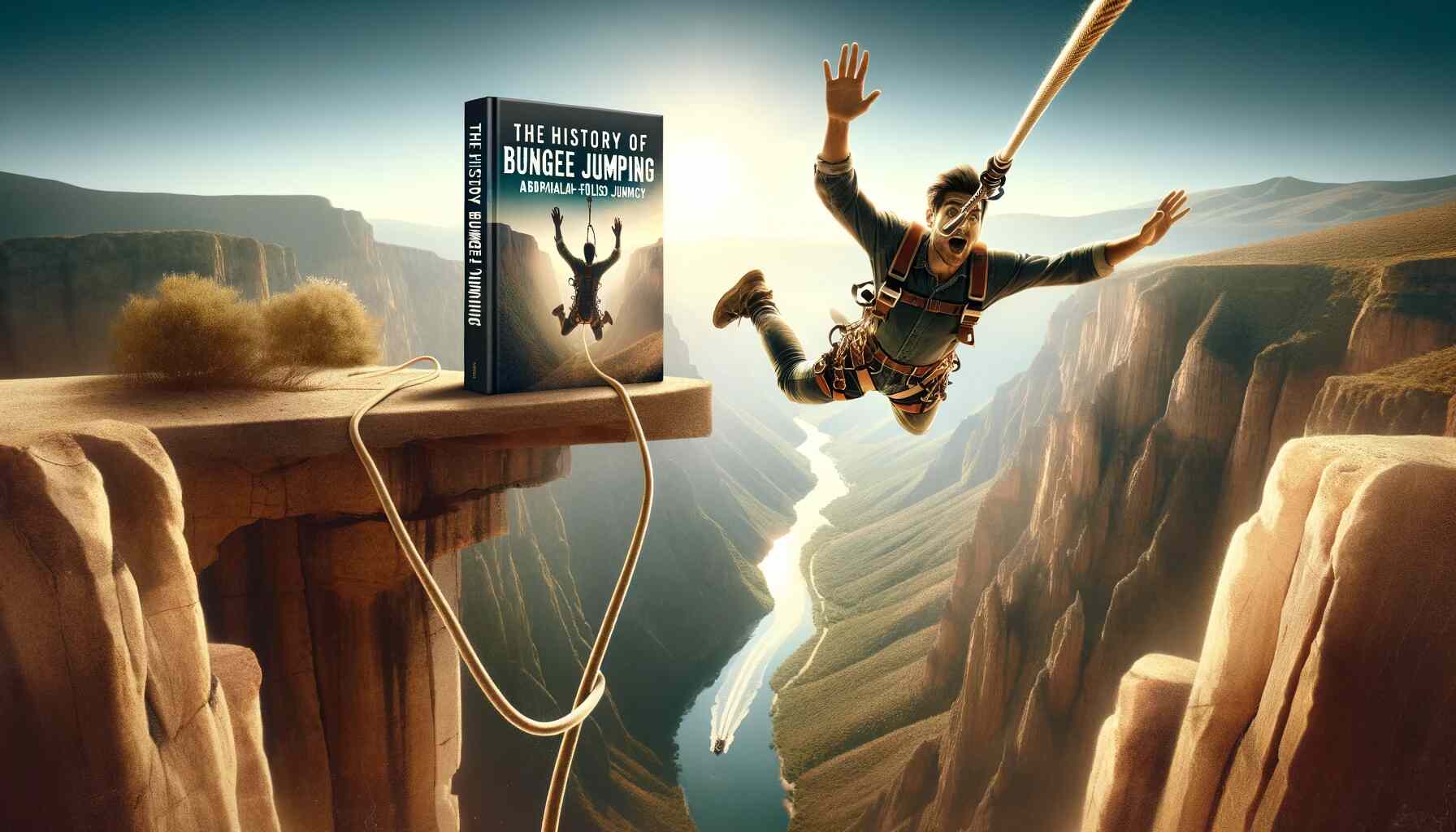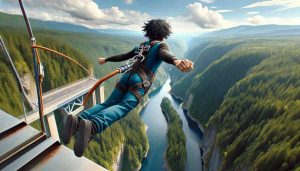For centuries, humans have sought out thrilling and daring activities to satisfy their innate desire for adventure and excitement. One such heart-pounding activity that has captured the imaginations of thrill-seekers around the world is bungee jumping. This exhilarating sport, which involves leaping off a high platform with a bungee cord attached to your ankles, offers an adrenaline rush like no other.
Let’s dive into the fascinating history of bungee jumping, tracing its origins, evolution, and cultural significance throughout the years.
Origins of Bungee Jumping
The roots of bungee jumping can be traced back to the Pacific Island nation of Vanuatu, where the practice of land diving has been a tradition for centuries. Land diving, also known as N’gol, is an ancient rite of passage for the men of the Pentecost Island. The villagers would construct wooden towers, often reaching up to 100 feet in height, and attach vines to their ankles before making the daring leap. The goal was not just to experience the thrill of the fall but also to ensure a bountiful yam harvest. The belief was that by successfully diving, the divers would demonstrate their courage to the gods and secure a good harvest.
The influence of land diving on modern bungee jumping is unmistakable. It was during a visit to Pentecost Island in the early 1950s that a New Zealand adventurer named A.J. Hackett was inspired by the daring leaps of the local men. Hackett would go on to become one of the key figures in the development of bungee jumping as a commercial sport.
The Birth of Commercial Bungee Jumping
While the land divers of Pentecost Island had been practicing their daring leaps for centuries, it wasn’t until the 1970s that bungee jumping as we know it today began to take shape. In 1979, A.J. Hackett and his friend Henry van Asch, both from New Zealand, embarked on a journey to develop a modern version of the land dive. Their vision was to create a commercial attraction that combined the thrill of free-fall with safety measures that would make it accessible to a wider audience.
Hackett and van Asch started experimenting with various materials to create the perfect bungee cord. They eventually settled on latex rubber, which provided the necessary elasticity to allow for a controlled rebound after the jump. In 1986, they opened the world’s first commercial bungee jumping operation at the Kawarau Bridge in Queenstown, New Zealand.
The jump from the Kawarau Bridge was a modest 43 meters (141 feet), but it marked a significant milestone in the history of bungee jumping. Hackett and van Asch had successfully transformed an ancient tribal ritual into a modern adventure sport. The commercial bungee jumping experience included safety harnesses, trained staff, and a focus on providing participants with an unforgettable rush of adrenaline.
The Rise of Bungee Jumping as a Global Phenomenon
The success of the Kawarau Bridge jump in New Zealand sparked a global fascination with bungee jumping. As news of this daring activity spread, entrepreneurs and thrill-seekers from around the world began to set up their own bungee jumping operations. The sport quickly gained popularity in various countries, and jump sites began to appear on iconic structures such as bridges, cliffs, and even skyscrapers.
In the 1990s, bungee jumping reached new heights – both literally and figuratively. The Royal Gorge Bridge in Colorado, USA, became home to the highest commercial bungee jump in the world, with a staggering height of 321 meters (1,053 feet). This jump offered a breathtaking free-fall experience like no other and attracted adrenaline junkies from across the globe.
Bungee jumping also made its way into popular culture during this period. It became a staple in adventure travel documentaries and was featured in numerous action movies and television shows. The sport’s appeal extended beyond thrill-seekers, capturing the imagination of people who craved a unique and unforgettable experience.
Safety Measures and Regulation
With the rapid growth of bungee jumping as a commercial sport, safety became a paramount concern. While the sport offered a thrilling experience, it also posed risks if not executed with precision and care. There were instances of accidents and injuries at some jump sites, prompting governments and regulatory bodies to step in and establish safety standards.
Regulations and guidelines were put in place to ensure the safety of both jumpers and operators. These measures included regular inspections of jump equipment, training and certification requirements for staff, and strict adherence to weight and health restrictions for participants. The focus on safety helped enhance the sport’s credibility and allowed it to continue growing.
Bungee Jumping as a Cultural Phenomenon
Bungee jumping not only became a global sensation but also embedded itself in the cultural fabric of various societies. It was no longer just an extreme sport; it became a symbol of pushing one’s boundaries, conquering fears, and embracing life’s exhilarating moments.
The sport’s popularity was evident in its integration into events like festivals, charity fundraisers, and even weddings. Some couples opted for a bungee jump together as a way to symbolize taking the leap into married life. Bungee jumping also became a means of raising awareness and funds for charitable causes, with participants often seeking sponsors for their daring jumps.
Bungee jumping’s impact on popular culture extended to music, literature, and art. Songs, books, and artworks began to incorporate the thrill and excitement of the sport as a metaphor for taking risks and living life to the fullest. The symbolism of the bungee jump resonated with audiences worldwide, reinforcing its status as a cultural phenomenon.
The Thrill of Bungee Jumping
One of the key attractions of bungee jumping is the unparalleled rush of adrenaline it provides. The sensation of free-falling through the air before the bungee cord recoils is an experience that is difficult to replicate in any other activity. This adrenaline rush triggers a cascade of physiological responses in the body, including increased heart rate, heightened alertness, and a surge of feel-good hormones like adrenaline and endorphins.
For many, bungee jumping is not just about the physical sensation but also the mental challenge it presents. The moments leading up to the jump are filled with a mix of excitement and fear, as participants confront their own limitations and push themselves beyond their comfort zones. Overcoming that fear and taking the leap can be a profoundly empowering experience, instilling a sense of accomplishment and confidence.
The allure of bungee jumping also lies in its simplicity. Unlike other adventure sports that require extensive training and equipment, bungee jumping is accessible to people of various fitness levels and ages (with certain restrictions). It offers a quick and intense burst of excitement that can be enjoyed without the need for extensive preparation.
Bungee Jumping Around the World
As the popularity of bungee jumping continued to grow, jump sites sprang up in diverse locations around the world. Each jump site offers a unique experience, combining breathtaking natural landscapes with the thrill of the jump itself. Here are a few notable bungee jumping destinations:
- Queenstown, New Zealand: The birthplace of commercial bungee jumping, Queenstown boasts several iconic jump sites, including the Kawarau Bridge and the Nevis Bungy, one of the highest in the world.
- Royal Gorge Bridge, Colorado, USA: Offering the highest commercial bungee jump globally, this site allows participants to experience an incredible free fall amidst the stunning scenery of the Royal Gorge.
- Victoria Falls Bridge, Zambia/Zimbabwe: Bungee jumping off the Victoria Falls Bridge offers a truly breathtaking experience, with the mighty Zambezi River and the majestic Victoria Falls as your backdrop.
- Macau Tower, Macau, China: For an urban bungee jumping experience, the Macau Tower offers a thrilling leap from a height of 233 meters (764 feet) above the cityscape.
- Verzasca Dam, Switzerland: Featured in the opening scene of the James Bond film “GoldenEye,” the Verzasca Dam is a popular jump site known for its crystal-clear waters and stunning Alpine surroundings.
- Bloukrans Bridge, South Africa: The Bloukrans Bridge bungee jump is renowned for its picturesque location along the Garden Route and its status as one of the highest commercial jumps in the world.
- The Last Resort, Nepal: Located near the Nepal-Tibet border, this jump site offers the opportunity to plunge into the Bhote Kosi River gorge while taking in the Himalayan scenery.
The Future of Bungee Jumping
Bungee jumping has come a long way since its humble beginnings on the Pentecost Island. Today, it continues to thrive as an adventure sport and cultural phenomenon. However, the sport is not without its challenges and controversies.
Environmental Concerns: Some bungee jump sites have faced criticism for their environmental impact. Jumping from natural landmarks can disturb local ecosystems and wildlife. Conservationists and environmentalists are advocating for responsible practices and sustainable tourism at these locations.
Safety and Regulation: Maintaining strict safety standards and regulations is crucial for the future of bungee jumping. Operators must prioritize the safety of their participants, and governments must enforce and update safety guidelines as needed.
Innovation: To keep the sport fresh and exciting, operators are continually looking for ways to innovate. This may include developing new types of jumps, incorporating virtual reality experiences, or creating unique jump sites in previously unexplored locations.
Accessibility: Making bungee jumping more accessible to a wider range of people, including those with disabilities, is an important consideration for the future. Adaptable equipment and training programs can help achieve this goal.
Conclusion
Bungee jumping has evolved from an ancient tribal ritual to a global adventure sport and cultural phenomenon. Its history is a testament to human ingenuity and our unending quest for excitement and adrenaline. From the lush jungles of Vanuatu to the towering bridges of Colorado, bungee jumping has left an indelible mark on the world of adventure and exploration.
As bungee jumping continues to evolve, its allure remains as strong as ever. The thrill of free-fall, the rush of adrenaline, and the sense of conquering fear continue to draw people from all walks of life to experience the exhilarating leap into the unknown. Whether you’re seeking the ultimate adrenaline rush or a profound personal challenge, bungee jumping offers an adventure like no other. So, if you’re ready to take the plunge, the world of bungee jumping awaits, promising an unforgettable journey into the world of adrenaline-fueled excitement.










